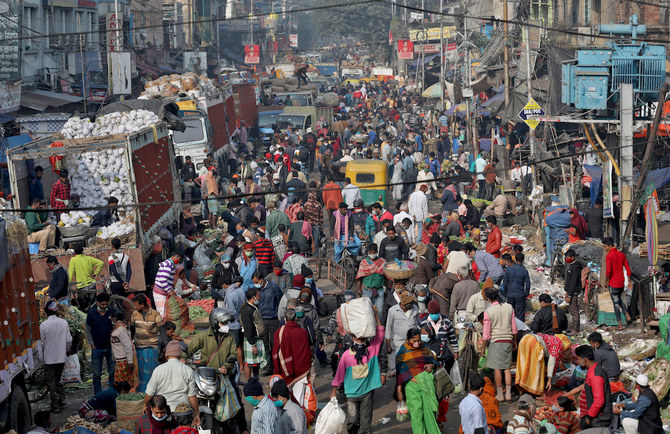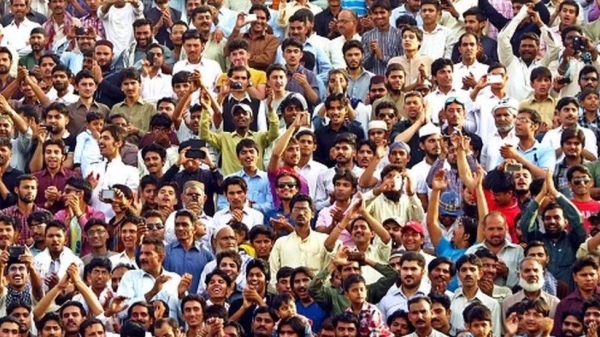
Recent media headlines around the world have been dominated by US President Joe Biden’s re-election campaign announcement, and the ongoing war in Ukraine. However, lurking under the international radar there is another key development, in Asia, that could mark a tectonic shift in global economics and politics.
India is forecast, as soon as this week, to emerge as the most populous nation in the world in what is potentially a big moment in human history as China hands over the “baton.” It means the nation that has long been the world’s largest democracy now becomes the world’s largest country of any political or social stripe, a position it might hold for centuries to come.
India’s population is expected to reach 1,425,775,850 by the end of April, surpassing that of China, according to the UN, which also forecasts that by the middle of this year, the former will have 2.9 million more people than the latter.
What this underlines is the fact that though the two Asian nations have accounted for more than a third of the global population for more than seven decades, there are key differential trends between the two.
China’s birth rate has plunged recently. Its population shrank last year for the first time since 1961 and could drop below 1 billion before the end of the century.
The higher fertility rate in India means its population is forecast to continue growing for several decades, with some predictions suggesting it could peak at about 1.7 billion in the second half of the century.
Moreover, India’s population between the ages of 15 and 24 numbers more than 250 million, the largest in the world, and more than two-thirds of the country’s total population is between the ages of 15 and 59. Therefore, the ratio of young people and retirees to working age adults is very low.
A key question for the nation’s policymakers is whether, and how, they will seek to leverage this new global population stature, with some talk of an “Indian century.” The milestone comes at a time when New Delhi, as first-time host of this year’s G20, is attempting to promote itself as a rising international player.
Amid the uncertainty, one thing that is certain is that demography is not necessarily destiny, and it is by no means assured that the nation will become a new global superpower. Sure, India’s economy is growing but it has not yet delivered the kind of huge, export-driven manufacturing growth that has made China such a global economic dynamo.
Specifically, the success of the nation in terms of delivering a dividend from its population growth will depend, to a significant degree, on whether it can overcome the challenges that have constrained growth in recent decades. These include scarcity of infrastructure; suboptimal political governance; insufficient social spending, including investment in education; and subpar regulatory regimes in a number of sectors, including the labor market.
India’s emergence as the world’s most populous nation brings with it many challenges, as well as opportunities.
Andrew Hammond
Turning to the big picture on a global level, India is one of a small number of countries in Asia and Africa — including the Democratic Republic of the Congo, Ethiopia, Nigeria, Pakistan, the Philippines and Tanzania — in which more than half of global population growth during the period up to 2050 is forecast.
This underlines how geographically unbalanced the next phase of demographic change will be as the overall population of the world grows from about 8 billion now to a peak of about 10.4 billion in the second half of this century.
As significant as this spurt of population growth will potentially be, however, the rate of the increase is slowing and is at its lowest since 1950. This is true even in India, where fertility has decreased from 5.7 births per woman in 1950 to 2.2 births.
Indeed, in dozens of countries the population is expected to decrease by at least 1 percent over the next three decades. This is the result of sustained low levels of fertility and, in some cases, higher rates of emigration.
These global population dynamics are driving another megatrend too — urbanization. Take the example of India, which is experiencing the second-largest rural-to-urban migration in human history. This is part of a much bigger global story. In 1800, less than 3 percent of the world’s population lived in cities. By the end of 2008 this had risen to more than 50 percent, and the proportion is expected to increase to 68 percent by 2050.
Occurring in parallel with this trend is the rise of megacities — defined as cities with 10 million or more inhabitants — of which there were 26 in 2008. By 2025, it is forecast that Asia alone will have at least 30 megacities, including Mumbai, Shanghai and New Delhi.
Despite the general economic success of such megacities, governments in many countries, including India, are preparing for the growing risks these massive urban centers pose. Key questions that need to be addressed include whether it will be possible to continue to meet everyday needs such as food, water and health, and also deal with the growing vulnerability of large urban areas to environmental stresses exacerbated by climate change.
Therefore, while many in India might welcome its emergence as the world’s most populous nation, the milestone brings with it many challenges, as well as opportunities. If policymakers are to deliver a significant dividend from it, they will need to enhance the standards of political governance; increase social spending, including money spent on health; boost infrastructure; and improve regulatory regimes.
Andrew Hammond is an associate at LSE IDEAS at the London School of Economics.












